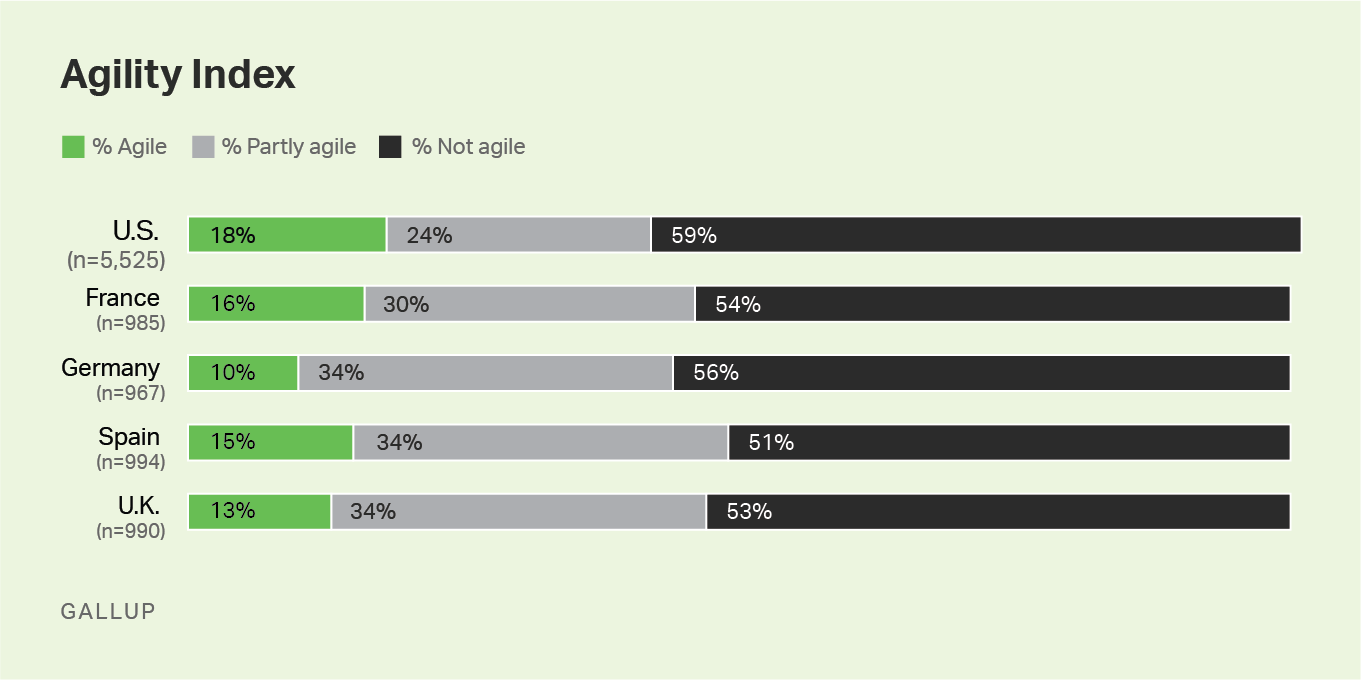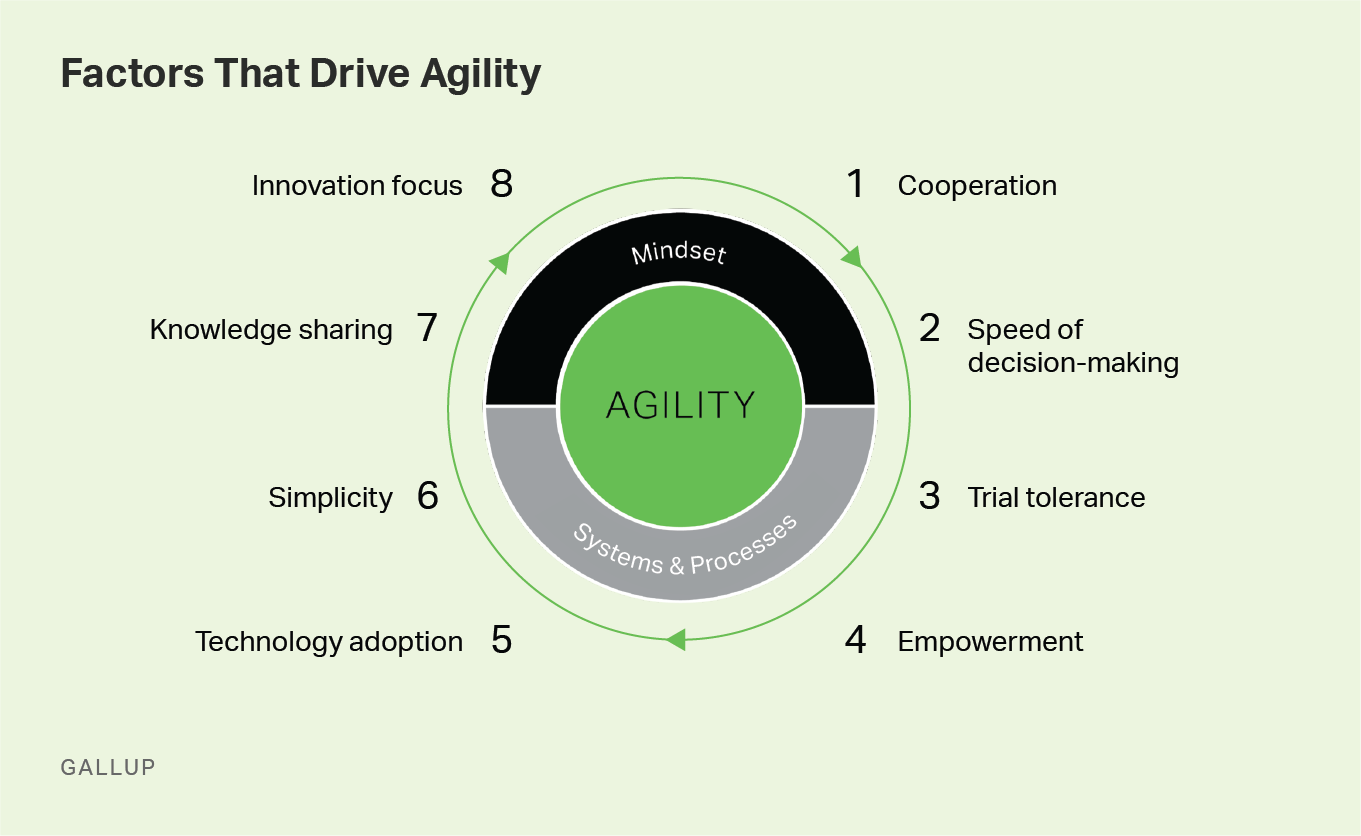Story Highlights
- Companies make decisions only as fast as their culture allows
- Fast decisions require simple processes -- but most are needlessly complex
- Speed decision-making by removing outdated policies
This is the second article in a series for leaders about agility. Don't miss the first article.
In late 2017 and into early 2018, Gallup conducted stakeholder interviews with 80 U.S. and EU business leaders and managers about their experience of agility in their companies.
Most of them agreed that their organization needs to foster a stronger culture of agility to respond quickly to business needs -- but their definitions of agile's attributes were all over the board, everything from less complex to more cooperative.
Still, a pattern arose in the interviews, and from it, Gallup analytics found that when employees can strongly agree that:
- "In my company, we have the right tools and processes to respond quickly to business needs" and
- "In my company, we have the right mindset to respond quickly to business needs"
their companies tend to have certain basics of agility, including fast decision-making, as well.
But only a minority of those 5,500 American and 4,000 French, German, British and Spanish workers can say their organizations have the right processes and mindset.
That may be one reason they also say making decisions quickly feels like such a struggle.

Hallmark of Agility
Decisions have consequences, of course, and impulsive haste is dangerous.
But protracted decision-making has its costs, too, and only 18% in Europe and 14% in the U.S. are satisfied with the speed with which their companies make decisions.
Meanwhile, only 29% of workers in Europe and 13% in the U.S. can say that "In my company, we always look for the simplest way to get the job done."
Companies that build complications into their processes inadvertently create speed bumps for themselves because those processes usually up the number of decisions that have to be made.
And the more decisions, the longer it takes to fulfill a customer's need.
That compromised capacity for agile is a result of an organization's processes and mindset, which are an expression of its culture.
Altering that aspect of culture almost always involves changing the company's policies about -- and its employees' mindset toward -- local decisions and local responsibilities.
The more decisions that have to be made, the longer it takes to fulfill a customer's need.
A good place to start is with simplifying processes.
Processes and Mindset
Remember those speed bumps that complexity creates? Flatten them.
It's a good way to start changing mindset, and shedding useless rules and low-value activities can have a quick, positive effect on the workflow and the employee experience.
The key is to determine what's really important and what's not.
A close review will show that some processes, policies and rules are relics of an outdated strategy. Some were designed to prevent minor problems. Some, however, were designed to protect personal fiefdoms.
So, fair warning, democratizing the authority structure for decision-making can summon a powerful fear of loss among people who depend on bureaucracy to put walls between "us" and "them."
They may resent ceding control, even though agile's speed depends on local teams taking responsibility for local decisions. Shedding rules can invite pushback.
Gallup's advice is to evaluate processes, policies and rules with the customer in mind.
A tight focus on the customer makes it easier to root out extra steps and make processes lean. And behind every rule there are customers -- though you may have to squint to see them in the distance -- who can be prioritized.
Consider: a rule about multidepartmental project signoff -- does that signoff make it easier to meet customer expectations?
Or office-space policy: Does allocating space to teams by headcount or job-specific inputs get the highest-quality projects out the door faster?
Is feedback on the customer experience weighted properly and does that feedback influence process? Strategy? The product itself? And who decides?
As soon as you feel like you have this solved, do a review.
Gallup's advice is to evaluate processes, policies and rules with the customer in mind.
Re-assess the priority list as new products or methods are added.
Complexity is like a weed in the garden -- shift your attention away and it creeps right back.
And every additional step reflects more decisions that have to be made before a product can meet a customer.
Change Order
The fact is, companies make decisions only as fast as their cultures allow them to.
Simplifying processes is one factor in increasing the speed of decision-making. But it's only one, and there are many.
Along with the qualitative research from the stakeholder interviews, Gallup used quantitative data to create strategies and methods to help companies understand -- and, if need be, improve -- agility in the workplace.
A key finding from that research, as noted above, is that agility requires the right tools, systems, and processes and the right mindset.
Agile processes and mindset are cultural factors.
Cultures that support them tend to have certain elements that drive agility. Eight of them, in fact, and they work in concert.

The most agile companies support -- even celebrate -- these agility basics. But most companies aren't very agile, and creating a culture that reinforces the elements of agility takes intentional intervention.
To increase velocity requires changing the culture to support an agile mindset and agile processes. And that's a tall order.
Simplifying processes can help clarify which decisions are necessary to the customer experience, and which gum up the works.
Leaner processes -- and fewer decision-making cooks in the kitchen -- can start a cultural cascade.
To increase velocity requires changing the culture to support an agile mindset and agile processes.
Leaders have to push for it, but speeding decisions by reducing processes can ignite all the other cultural changes true agility requires.
And yes, culture is hard to change. Mindset is hard to change. Processes are hard to change.
But being second or third to market is hard to swallow.
So before a company can truly go agile, its leaders have to decide which they care about more: maintaining the current culture or gaining the future customer.
A quick decision is required.
Gallup can help you improve customer centricity by developing an agile workplace.
- Download the Agility issue of our online publication, The Real Future of Work.
- Learn how we can partner with you to create a culture of agility across your organization.



